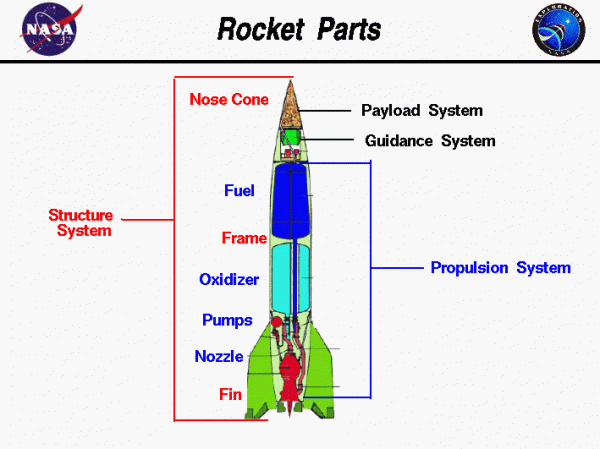Rocket Parts

The Systems of Rockets
The study of rockets is an excellent way for students to learn the basics of forces and the response of an object to external forces. In flight, a rocket is subjected to the forces of weight, thrust, and aerodynamics. On this slide, we have removed the outer “skin” so that we can see the parts that make a rocket. There are many parts that make up a rocket. For design and analysis, engineers group parts which have the same function into systems. There are four major systems in a full-scale rocket: the structural system, the payload system, the guidance system, and the propulsion system.
Structural System
The structural system, or frame, is similar to the fuselage of an airplane. The frame is made from very strong but lightweight materials, like titanium or aluminum, and usually employs long “stringers” which run from the top to the bottom which are connected to “hoops” which run around the circumference. The “skin” is then attached to the stringers and hoops to form the basic shape of the rocket. The skin may be coated with a thermal protection system to keep out the heat of air friction during flight and to keep in the cold temperatures needed for certain fuels and oxidizers. Fins are attached to some rockets at the bottom of the frame to provide stability during the flight.
Payload System
The payload system of a rocket depends on the rocket’s mission. The earliest payloads on rockets were fireworks for celebrating holidays. The payload of the German V2, shown in the figure, was several thousand pounds of explosives. Following World War II, many countries developed guided ballistic missiles armed with nuclear warheads for payloads. The same rockets were modified to launch satellites with a wide range of missions; communications, weather monitoring, spying, planetary exploration, and observatories, like the Hubble Space Telescope. Special rockets were developed to launch people into Earth orbit and onto the surface of the Moon.
Guidance System
The guidance system of a rocket may include very sophisticated sensors, on-board computers, radars, and communication equipment to maneuver the rocket in flight. Many different methods have been developed to control rockets in flight. The V2 guidance system included small vanes in the exhaust of the nozzle to deflect the thrust from the engine. Modern rockets typically rotate the nozzle to maneuver the rocket. The guidance system must also provide some level of stability so that the rocket does not tumble in flight.
Propulsion System
As you can see on the figure, most of a full-scale rocket is the propulsion system. There are two main classes of propulsion systems, liquid rocket engines and solid rocket engines. The V2 used a liquid rocket engine consisting of fuel and oxidizer (propellant) tanks, pumps, a combustion chamber with nozzle, and the associated plumbing. The Space Shuttle, Delta II, and Titan III all use solid rocket strap-ons.
The various rocket parts described above have been grouped by function into structure, payload, guidance, and propulsion systems. There are other possible groupings. For the purpose of weight determination and flight performance, engineers often group the payload, structure, propulsion structure (nozzle, pumps, tanks, etc.), and guidance into a single empty weight parameter. The remaining propellant weight then becomes the only factor that changes with time when determining rocket performance.
